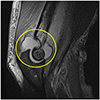Abstract
Purpose
To report a case of endogenous endophthalmitis with an elbow abscess spread from a liver abscess in a patient with hypervirulent Klebsiella pneumoniae (hvKP) invasive syndrome.
Case summary
A 33-year-old healthy male presented with painless visual loss in his right eye. He experienced pain, a febrile sensation, and swelling in his right elbow for 1 week prior. He had no trauma history. Many inflammatory cells, hypopyons, and cyclitic membranes were present in the anterior chamber of the eye but no ocular injection was performed. With a provisional diagnosis of panuveitis, topical antibiotics, steroid, and cycloplegics were administered and subtenon triamcinolone was injected. After orthopedic consultation, an elbow abscess was suspected and surgery was performed. Two days after the surgery, the patient experienced ocular pain and an injection was performed. Fever, chill, and acute deterioration of his general condition were noted which suggested infective endophthalmitis. Emergency vitrectomy was performed but because subretinal and choroidal abscesses were observed during surgery, the surgery was changed to enucleation. A liver abscess was observed using abdominal computed tomography after transfer to the infection medical department and hvKP was positive in the blood, liver, elbow, and eye cultures.
Figures and Tables
Figure 1
Anterior segment photograph and B-scan ultrasonography at first visit. (A) Anterior segment photograph shows inflammatory cells, hypopyon, cyclitic membrane and posterior synechiae. (B) B-scan ultrasonography shows vitreous opacity.

Figure 2
Magnetic resonance imaging finding. Enhanced contrast within the elbow joint consistent with elbow joint abcess (yellow circle).

References
1. Siu LK, Yeh KM, Lin JC, et al. Klebsiella pneumoniae liver abscess: a new invasive syndrome. Lancet Infect Dis. 2012; 12:881–887.
2. Okada AA, Johnson RP, Liles WC, et al. Endogenous bacterial endophthalmitis. Report of a ten-year retrospective study. Ophthalmology. 1994; 101:832–838.
3. Han JM, Kim NJ. Two Cases of bilateral endogenous Klebsiella pneumoniae endophthalmitis in primary Klebsiella pneumoniae liver abscess patients. J Korean Ophthalmol Soc. 2009; 50:1590–1594.
4. Jung SI, Han JS, Yang JH, Kim DG. An unusual case of endogenous klebsiella pneumonia endophthalmitis. J Korean Ophthalmol Soc. 2017; 58:1301–1306.
5. Wang JH, Liu YC, Lee SS, et al. Primary liver abscess due to Klebsiella pneumoniae in Taiwan. Clin Infect Dis. 1998; 26:1434–1438.
6. Shon AS, Bajwa RP, Russo TA. Hypervirulent (hyper mucoviscous) Klebsiella pneumoniae: a new and dangerous breed. Virulence. 2013; 4:107–118.
7. Ang M, Jap A, Chee SP. Prognostic factors and outcomes in endogenous Klebsiella pneumoniae endophthalmitis. Am J Ophthalmol. 2011; 151:338–344.e2.
8. Suh DS, Roh JH, Kim SD. Surgical management of infectious endophthalmitis: early vitrectomy vs late vitrectomy. J Korean Ophthalmol Soc. 1998; 39:2418–2425.
9. Zhang YQ, Wang WJ. Treatment outcomes after pars plana vitrectomy for endogenous endophthalmitis. Retina. 2005; 25:746–750.
10. Jung SW, Chae HJ, Park YJ, et al. Microbiological and clinical characteristics of bacteraemia caused by the hypermucoviscosity phenotype of Klebsiella pneumoniae in Korea. Epidemiol Infect. 2013; 141:334–340.
11. Cheng NC, Yu YC, Tai HC, et al. Recent trend of necrotizing fasciitis in Taiwan: focus on monomicrobial Klebsiella pneumoniae necrotizing fasciitis. Clin Infect Dis. 2012; 55:930–939.




 PDF
PDF ePub
ePub Citation
Citation Print
Print




 XML Download
XML Download